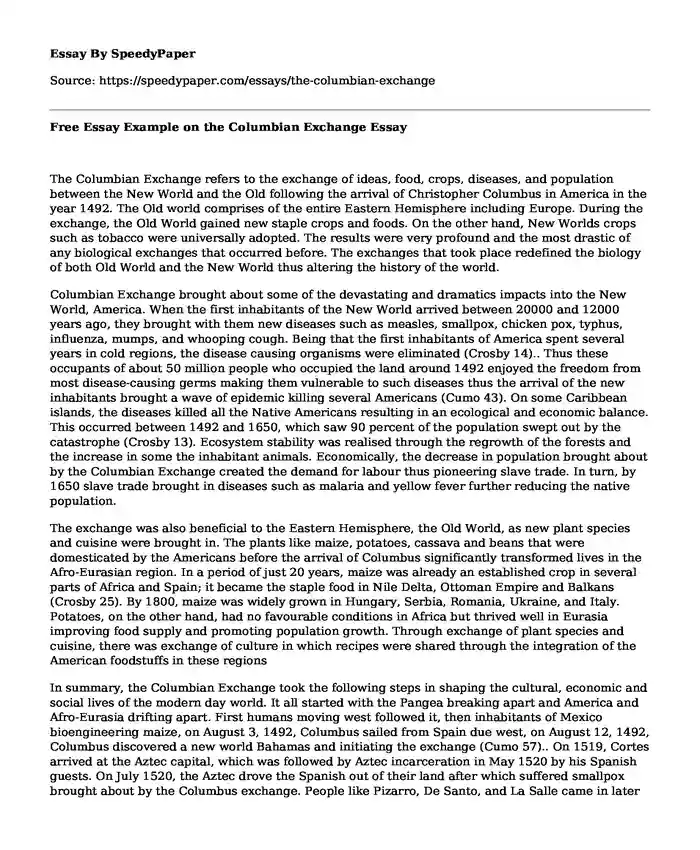
| Type of paper: | Essay |
| Categories: | History United States Christopher Columbus |
| Pages: | 3 |
| Wordcount: | 632 words |
The Columbian Exchange refers to the exchange of ideas, food, crops, diseases, and population between the New World and the Old following the arrival of Christopher Columbus in America in the year 1492. The Old world comprises of the entire Eastern Hemisphere including Europe. During the exchange, the Old World gained new staple crops and foods. On the other hand, New Worlds crops such as tobacco were universally adopted. The results were very profound and the most drastic of any biological exchanges that occurred before. The exchanges that took place redefined the biology of both Old World and the New World thus altering the history of the world.
Columbian Exchange brought about some of the devastating and dramatics impacts into the New World, America. When the first inhabitants of the New World arrived between 20000 and 12000 years ago, they brought with them new diseases such as measles, smallpox, chicken pox, typhus, influenza, mumps, and whooping cough. Being that the first inhabitants of America spent several years in cold regions, the disease causing organisms were eliminated (Crosby 14).. Thus these occupants of about 50 million people who occupied the land around 1492 enjoyed the freedom from most disease-causing germs making them vulnerable to such diseases thus the arrival of the new inhabitants brought a wave of epidemic killing several Americans (Cumo 43). On some Caribbean islands, the diseases killed all the Native Americans resulting in an ecological and economic balance. This occurred between 1492 and 1650, which saw 90 percent of the population swept out by the catastrophe (Crosby 13). Ecosystem stability was realised through the regrowth of the forests and the increase in some the inhabitant animals. Economically, the decrease in population brought about by the Columbian Exchange created the demand for labour thus pioneering slave trade. In turn, by 1650 slave trade brought in diseases such as malaria and yellow fever further reducing the native population.
The exchange was also beneficial to the Eastern Hemisphere, the Old World, as new plant species and cuisine were brought in. The plants like maize, potatoes, cassava and beans that were domesticated by the Americans before the arrival of Columbus significantly transformed lives in the Afro-Eurasian region. In a period of just 20 years, maize was already an established crop in several parts of Africa and Spain; it became the staple food in Nile Delta, Ottoman Empire and Balkans (Crosby 25). By 1800, maize was widely grown in Hungary, Serbia, Romania, Ukraine, and Italy. Potatoes, on the other hand, had no favourable conditions in Africa but thrived well in Eurasia improving food supply and promoting population growth. Through exchange of plant species and cuisine, there was exchange of culture in which recipes were shared through the integration of the American foodstuffs in these regions
In summary, the Columbian Exchange took the following steps in shaping the cultural, economic and social lives of the modern day world. It all started with the Pangea breaking apart and America and Afro-Eurasia drifting apart. First humans moving west followed it, then inhabitants of Mexico bioengineering maize, on August 3, 1492, Columbus sailed from Spain due west, on August 12, 1492, Columbus discovered a new world Bahamas and initiating the exchange (Cumo 57).. On 1519, Cortes arrived at the Aztec capital, which was followed by Aztec incarceration in May 1520 by his Spanish guests. On July 1520, the Aztec drove the Spanish out of their land after which suffered smallpox brought about by the Columbus exchange. People like Pizarro, De Santo, and La Salle came in later making in the process of Columbus Exchange a great success.
Works Cited
Crosby, Alfred W. The Columbian Exchange: Biological and Cultural Consequences of 1492. Westport, Conn: Greenwood Press, 1972. Print.
Crosby, Alfred W. The Columbian Voyages, the Columbian Exchange, and Their Historians. Washington, DC: American Historical Association, 1987. Print.
Cumo, Christopher. The Ongoing Columbian Exchange: Stories of Biological and Economic Transfer in World History. , 2015. Internet resource.
Cite this page
Free Essay Example on the Columbian Exchange. (2019, Oct 29). Retrieved from https://speedypaper.com/essays/the-columbian-exchange
Request Removal
If you are the original author of this essay and no longer wish to have it published on the SpeedyPaper website, please click below to request its removal:
- Essay Example on Reserves in the Petroleum
- Essay About Bullying Solution | Free Paper Sample | SpeedyPaper
- Free Essay on Ideal Relationship Between Boss and Employee
- Essay Example: Frantz Fanon's CV
- Andrew Jackson and the Indian Policy, Free Essay for Students
- Essay Sample on Leadership Styles in Nursing
- Interagency Collaboration and Homeland Security - Free Paper Sample
Popular categories




